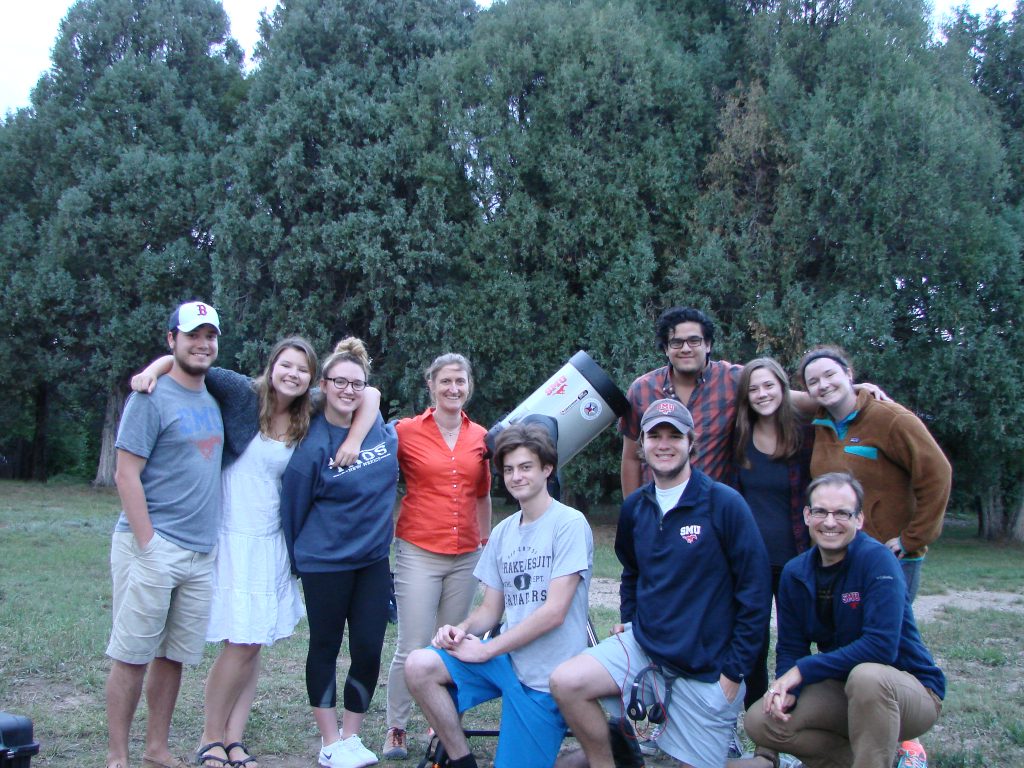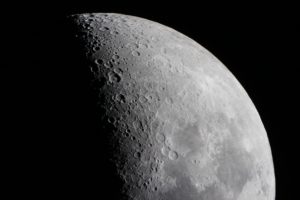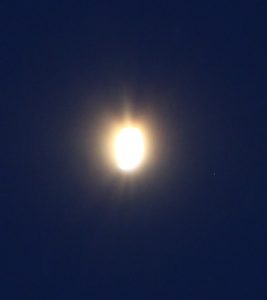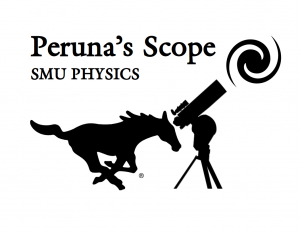
The summer was mostly filled with research, and, in fact, this made for a very productive summer. By the end of July, the physics analysis that I work on within the ATLAS Collaboration – the search for H->bb decay (Higgs decays to bottom quarks) – was presented publicly at the International Conference on High-Energy Physics (ICHEP) in Chicago [1]. We were only able to finish the analysis in time for a big summer conference using part of the available data, and by now we’ve collected nearly twice the data that was used for ICHEP, which means that the upcoming cycle of winter conferences will be stressful and, I hope, exciting.
The end of summer is marked on my experiment by vacations. My European colleagues take nearly all of August off. As a result (and because, as a faculty member, I am not paid for work for most of August), I also usually take vacation. Not this year. This year, Jodi and I did something we’ve talked about for years: co-taught a course on the Taos Campus of SMU (SMU-in-Taos). So while physics analyses from ATLAS and CMS were being shown off in Chicago, Jodi and I hit the road for Taos, NM and 12 intense teaching days.
The August Term, as it is called, stretched from August 4 to August 19. This puts two weekends in the term; the weekdays make for the teaching days for a classroom-based course (as opposed to an outdoor “wellness” course, which many students take when they do August Term in Taos). With just 12 teaching days to teach a 15-week course, this is a compressed and challenging schedule. That is true not only for the students (for whom a science course is then a very intense experience) but also for the instructors, especially those who had not yet taught a course on the Taos Campus.
Jodi and I had proposed last year that the Physics Department’s “Elements of Astronomy (PHYS 1311)” introductory Astronomy course be taught in August Term. The last time the course had been taught at Taos was about 16 years ago, and then it was in the longer “May Term” – a still-compressed but slightly longer term. Since then, the course had not been brought back to Taos. Jodi and I found the administrators and staff on the Taos Campus extremely eager to see the course return, and while I am not an Astronomer, Jodi is a seasoned Astrophysicist and both of us have a passion for the cosmos. The hallmark of being a good physicist is a willingness to learn new things, and on the academic side of the field also the ability to teach new classes. I had always wanted to learn basic Astronomy; what better way to learn it than to have to teach it to students equally eager to learn the subject?
Taos offers several key advantages over teaching Astronomy on the main Dallas Campus. First, the nights (when clear) are AMAZINGLY CLEAR. You can see the band of stars that form the disc of the Milky Way, our home galaxy. It appears, to the eye of a city-slicker, like a cloud in the night sky that just won’t get out of the way. There are stars in our interstellar neighborhood that stand out, even in a city – Vega, Polaris (a cluster of stars), Arcturus, Antares – but in Taos they are joined by a chorus of dim points that twinkle in the shifting airmass above your head. The lack of city lights on the Taos Campus, located in Ranchos de Taos (about 8 miles from Taos proper in a valley of the Sangre de Christo Mountains), makes for an excellent overall reach to see fainter objects in the night sky.
Another key advantage, I feel, is the intimate setting and the compressed timescale. Faculty and students live together in the Taos Campus, with faculty located in the Officers’ Quarters or “Faculty Casitas” and students located across the small campus in the “Student Casitas”. In the middle is the common social area – the Miller Campus Center, with its brand new rooms beautiful for studying or for holding discussions; the dining hall, with its outstanding staff and delicious food, prepared from recipes of the staffs’ own devising (including an amazing potato and green chili soup). The central campus area is the social glue, where students and faculty take their meals together; study in close proximity to one another; socialize through TV- or movie-watching. This is a unique experience. Jodi and I live 20 miles from SMU. We go home early to beat traffic, and we get up early to do the same. When students are out of class, we are no longer there to talk to them or socialize with them. At the Taos Campus, there is no “commute home” – you live and work at home for 16 days, and it is an amazing experience. Students are supposed to only take 2 courses, and only 1 of them can be a classroom-intense course.
There are disadvantages to the Taos Campus. The schedule is compressed; you have to pack the equivalent semester-long course into just 12 teaching days, including labs (for a science course) and exams. We opted for daily lecture and labs, daily quizzing and homework, and a single final exam. With hindsight, we know how we would improve the course, but nonetheless we felt that it went well for this past August Term. Another disadvantage is the mountains; they block views of low sky objects, but much more importantly the air currents OVER the mountains create more atmospheric distortion than you see in Dallas. So while Dallas offers too much light pollution but very still air, Taos offers the opposite. On balance, it’s worth it. For the kind of sky viewing we want to do – taking in the wonder of the cosmos while focusing on a few easy-to-see objects – it worked well for our course.

My favorite part were the telescope viewing nights. Jodi, a graduate student (Matt), and I had successfully earned an SMU President’s Partners Grant to purchase a new teaching telescope. We opted for a very nice Celestron, as the recommendation of Matt. As an 11-inch reflector, in combination with our selection of eyepieces it offers a 300-times magnification. With still air, this affords incredible views of the Moon, Mars, Saturn, and Jupiter. At Taos, Saturn was still amazing (the rings and the Cassini gap in the rings were clearly visible) if blurry; the Moon was hauntingly detailed, even with atmospheric distortion; Mars was a rusty blur, whose gross features (the darker, older hemisphere of the planet and the brighter, smoother, newer hemisphere of the planet) were clear enough. But we were also able to show students the colors of stars, and from their classroom learning they could link color to life cycle.

There is the red-orange supergiant, Antares. Antares is currently burning Helium and has swollen to a size 883-times that of our own Sun. This is so large that in our Solar System, it would engulf the orbit of Mars. Antares is heavy enough that in a few hundred-thousand years it will develop an iron core and then core-collapse as a Type II supernova. It will be a spectacular light show. Antares has a blue giant partner star. They orbit so close that in our telescope, the Blue Giant cannot be seen on its own but rather as a distortion of the red-orange glow of Antares, appearing as a greenish smear on one side of Antares.
My other favorite was Mizar and Alcor, a binary pair of binary stars located in the handle of the Big Dipper (Ursa Major, the Great Bear). The kink in the handle of the dipper, Mizar and Alcor are an easily resolved pair of binary star systems. In our telescope, their gravitational relationship was clearly revealed, as one bright object visible to the naked eye splits quickly into two under even modest magnification.

The new telescope deserved a name, and our Astronomy students made suggestions. Those suggestions were then ranked by 9 other Taos faculty and a winner emerged: “Peruna’s Scope”, named in honor of our University’s mascot, the pony “Peruna”. We even made a cute little logo for the telescope; even ponies can take in the wonder of the cosmos.
Now, Jodi and I are back in Taos for the Hunt Leadership Scholar retreat. Dozens of Hunt Scholars, new and old, are spending the weekend here in Taos getting to know on another, bonding and forming the kinds of friendships that only College and a special program like this one can forge. The staff here at the campus were kind enough to let Jodi and I setup the 8-inch reflector that was left here from the last time Astronomy was taught, 16 years ago. It’s a nice telescope, still in good shape (though not half as fancy as “Peruna’s Scope”!), and last night we set it up under incredibly clear skies to show a new group of students the wonders of the cosmos. We talked about the edge of the Universe, the deaths of stars like Antares, and the beauty of Mars and Saturn. If the skies clear again tonight, we’ll invite students and faculty to join us one last time before we leave for home tomorrow afternoon.
SMU-in-Taos, for me, feels like the start of something wonderful. J. Robert Oppenheimer famously wrote once to a friend that “[His] two great loves [were] physics and desert country; it’s a pity they can’t be combined.” Of course, he did combine them when he became the leader of the Atomic Bomb Project at Los Alamos Laboratory during World War II, not far from here. I love the desert country too. I also love physics. I feel like SMU-in-Taos affords me a chance to combine them in a way far less controversial and terrifying than the making of an atomic bomb. Whether it’s opening the eyes of a student to the wonders of the night sky, or showing a student a view of a place they love but have not yet laid eyes on through a telescope, or teaching a course – introductory or advanced – in such a beauteous and isolated setting, I feel like a great love with this place has just been kindled. I want it to continue, to the good of all humankind.
[1] https://atlas.web.cern.ch/Atlas/GROUPS/PHYSICS/CONFNOTES/ATLAS-CONF-2016-091/

